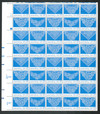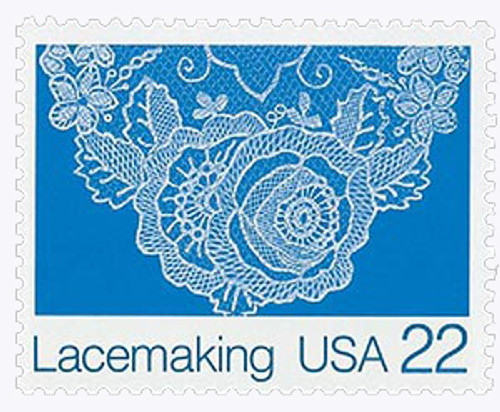
# 2351-54 - 1987 22c Lacemaking
U.S. #2351-54
1987 22¢ Lacemaking
American Folk Art Series
- 8th issue in American Folk Art Series
- Result of a 10-year campaign by Michigan lacemaker
- Pictures actual lace designs by four Michigan lacemakers
Stamp Category: Commemorative
Series: American Folk Art
Value: 22¢, first-class rate
First Day of Issue: August 14, 1987
First Day City: Ypsilanti, Michigan
Quantity Issued: 40,995,000 blocks of 4
Printed by: Bureau of Engraving and Printing
Printing Method: Lithographed & engraved
Format: Panes of 40 in sheets of 160
Perforations: 11
Color: Ultra and white
Why the stamps were issued: Lacemaker Mary McPeek of Ann Arbor, Michigan had campaigned the USPS for 10 years to issue a stamp honoring the delicate and detailed art of lacemaking.
About the stamp design: Initially, first-time stamp designer Libby Thiel was tasked with designing a single stamp to honor lacemaking. She traveled to Michigan to examine the work of McPeek’s Great Lakes Lacers Group in Ypsilanti. Should couldn’t decide what she liked best and narrowed it down to four designs. She submitted those four designs to the USPS and they too couldn’t decide, so the single stamp became a block of four.
The squash blossom design (#2351) was created by Ruth Maxwell of Dearborn, Michigan. Created in the Bucks Point style, she produced the design and background in one piece.
The woman largely responsible for getting the lacemaking stamps made, Mary McPeek, has her lacework featured on one of the floral design stamps (#2352).
One of the floral designs (#2353) was designed by Leslie K. Saari of Cadillac, Michigan. She used a mixed technique that combined bobbin lace with needle and tatting applique.
The dogwood blossoms design (#2354) was created by Trenna Ruffner of Grose Pointe Park, Michigan. Her “sprig” bobbin lace uses methods from the Honiton and Duchesse traditions.
About the printing process: The stamps were originally supposed to be issued in May 1986, however, the Bureau of Engraving and Printing (BEP) had issues reproducing the intricate lacework. They had previously tried engraving white over darker colors on stamps in the 1960s but were dissatisfied with the results. But the BEP insisted it would do these stamps justice. The BEP and USPS spent four experimenting with ways to make the stamps work. They tried embossing the lace designs to raise them above the background. They also tried using gravure, printing the background and letting the unprinted white paper show through for the designs. The BEP spent a great deal of time developing an opaque intaglio white ink that would print well on a dark color. A solution involving titanium was eventually discovered, though it required the printing sleeves to be rechromed.
The lacemaking stamps were printed on the D press by offset/intaglio. Two separate stations laid down different screens of blue for the background and type. This created a slightly rough surface, which the white ink was able to attach to, solving a problem in previous printings in which the white ink flaked.
First Day City: The First Day ceremony for these stamps was held at the McKenny Union of Eastern Michigan University in Ypsilanti, Michigan, as part of the 11th convention of the Michigan lacemaking group.
Unusual fact about these stamps: Error sheets missing the white intaglio lace have been found.
About the American Folk Art Series: The USPS created the Folk Art Series in 1977 to honor important and lesser-known items in American art and culture. Folk Art is loosely defined as the art of the everyday, rooted in traditions that come from community and culture and expressing cultural identity by conveying shared community values and aesthetics. The series lasted nearly 20 years and featured folk art including Pueblo pottery, quilts, Pennsylvania toleware, Pacific Northwest Indian Masks, duck decoys, Navajo Blankets, wood-carved figures, lacemaking, carousel animals, Indian headdresses, and carousel horses. Click here for more about the series.
History the stamps represent: “Lace” is taken from the Latin word meaning “noose” or “snare.” Early versions of lace were likely cutwork that involved removing squares from woven linen to create meshwork. Lace is generally classified into two groups – bobbin and needlework, though there are other types including knitted and crocheted lace. Needle and bobbin lacemaking can be traced back to the late 1500s, and was often made of linen, silk, gold, or silver thread.
U.S. #2351-54
1987 22¢ Lacemaking
American Folk Art Series
- 8th issue in American Folk Art Series
- Result of a 10-year campaign by Michigan lacemaker
- Pictures actual lace designs by four Michigan lacemakers
Stamp Category: Commemorative
Series: American Folk Art
Value: 22¢, first-class rate
First Day of Issue: August 14, 1987
First Day City: Ypsilanti, Michigan
Quantity Issued: 40,995,000 blocks of 4
Printed by: Bureau of Engraving and Printing
Printing Method: Lithographed & engraved
Format: Panes of 40 in sheets of 160
Perforations: 11
Color: Ultra and white
Why the stamps were issued: Lacemaker Mary McPeek of Ann Arbor, Michigan had campaigned the USPS for 10 years to issue a stamp honoring the delicate and detailed art of lacemaking.
About the stamp design: Initially, first-time stamp designer Libby Thiel was tasked with designing a single stamp to honor lacemaking. She traveled to Michigan to examine the work of McPeek’s Great Lakes Lacers Group in Ypsilanti. Should couldn’t decide what she liked best and narrowed it down to four designs. She submitted those four designs to the USPS and they too couldn’t decide, so the single stamp became a block of four.
The squash blossom design (#2351) was created by Ruth Maxwell of Dearborn, Michigan. Created in the Bucks Point style, she produced the design and background in one piece.
The woman largely responsible for getting the lacemaking stamps made, Mary McPeek, has her lacework featured on one of the floral design stamps (#2352).
One of the floral designs (#2353) was designed by Leslie K. Saari of Cadillac, Michigan. She used a mixed technique that combined bobbin lace with needle and tatting applique.
The dogwood blossoms design (#2354) was created by Trenna Ruffner of Grose Pointe Park, Michigan. Her “sprig” bobbin lace uses methods from the Honiton and Duchesse traditions.
About the printing process: The stamps were originally supposed to be issued in May 1986, however, the Bureau of Engraving and Printing (BEP) had issues reproducing the intricate lacework. They had previously tried engraving white over darker colors on stamps in the 1960s but were dissatisfied with the results. But the BEP insisted it would do these stamps justice. The BEP and USPS spent four experimenting with ways to make the stamps work. They tried embossing the lace designs to raise them above the background. They also tried using gravure, printing the background and letting the unprinted white paper show through for the designs. The BEP spent a great deal of time developing an opaque intaglio white ink that would print well on a dark color. A solution involving titanium was eventually discovered, though it required the printing sleeves to be rechromed.
The lacemaking stamps were printed on the D press by offset/intaglio. Two separate stations laid down different screens of blue for the background and type. This created a slightly rough surface, which the white ink was able to attach to, solving a problem in previous printings in which the white ink flaked.
First Day City: The First Day ceremony for these stamps was held at the McKenny Union of Eastern Michigan University in Ypsilanti, Michigan, as part of the 11th convention of the Michigan lacemaking group.
Unusual fact about these stamps: Error sheets missing the white intaglio lace have been found.
About the American Folk Art Series: The USPS created the Folk Art Series in 1977 to honor important and lesser-known items in American art and culture. Folk Art is loosely defined as the art of the everyday, rooted in traditions that come from community and culture and expressing cultural identity by conveying shared community values and aesthetics. The series lasted nearly 20 years and featured folk art including Pueblo pottery, quilts, Pennsylvania toleware, Pacific Northwest Indian Masks, duck decoys, Navajo Blankets, wood-carved figures, lacemaking, carousel animals, Indian headdresses, and carousel horses. Click here for more about the series.
History the stamps represent: “Lace” is taken from the Latin word meaning “noose” or “snare.” Early versions of lace were likely cutwork that involved removing squares from woven linen to create meshwork. Lace is generally classified into two groups – bobbin and needlework, though there are other types including knitted and crocheted lace. Needle and bobbin lacemaking can be traced back to the late 1500s, and was often made of linen, silk, gold, or silver thread.
















